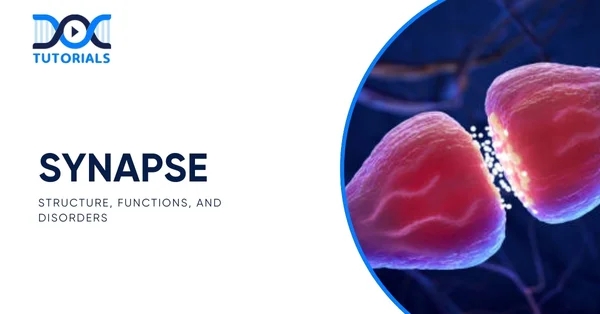Synapse: Structure, Functions, and Disorders

The human brain contains billions of neurons that exchange information with one another to regulate every thought, movement, and response. Instead of touching one another, they converse through special junctions known as synapses.
These minute gaps are where electrical or chemical messages travel from one neuron to a neighbouring neuron, or to an effector like a muscle or gland. Knowledge of synapse structure and function is vital in neuroscience, and for all NEET PG candidates, it serves as the foundation for most neurological principles.
Continue reading to understand synapses, their structure and functions.
What are Synapses?
A synapse is a specialised connection between two neurons or between a neuron and an effector cell like a muscle or gland to facilitate the passage of electrical or chemical signals. It has a vital function in neural signalling, ensuring the correct passage of information in the nervous system.
Synapses can be chemical, where neurotransmitters help with communication, or electrical, where ions move directly through gap junctions. Chemical synapses occur more in vertebrates, while electrical synapses can be found in vertebrates as well as invertebrates. Synapses are crucial in processes like movement, learning, memory, and brain functioning.
What are the Components of a Synapse?
A synapse consists of 3 main components:
- The presynaptic terminal, which houses neurotransmitters.
- The gap between the synapses of two nerve cells.
- The postsynaptic terminal segment contains receptor sites.
What is the Structure of Synapses?
A synapse is a junction which is used in the transmission of signals between two neurons or between a neuron and a target cell, such as a muscle. Synapse comprises 3 key components – the presynaptic neuron, the synaptic cleft, and the postsynaptic neuron.
Here’s a comprehensive breakdown of its structural features:
- A normal synapse contains a presynaptic neuron that transmits the impulse, a synaptic cleft, which is the gap between the two cells communicating, and a postsynaptic neuron which receives the impulse.
- The presynaptic neuron has a major function in storing and releasing the neurotransmitters and contains several vesicles within the axon terminal, such as granular vesicles, agranular (synaptic) vesicles, cisternae, coated vesicles, and endosomes.
- Synaptic vesicles, or agranular vesicles, are small (diameter 35–50 nm), round organelles that contain small-molecule neurotransmitters like glutamate and glycine, which are used for the rapid transmission of signals.
- Granular vesicles are somewhat larger (80–160 nm in diameter) and usually hold neuropeptides responsible for modulating synaptic activity and affecting longer-term responses of synapse neurons.
- The transport of synaptic vesicles towards the presynaptic membrane is facilitated by actin filaments, which form part of the cytoskeleton and are crucial for the positioning and transport of vesicles.
- A central regulatory protein, synapsin I, a phosphoprotein, is primarily responsible for controlling the availability and discharge of neurotransmitters from vesicles to the synaptic cleft.
- The active zone is a region within the presynaptic membrane where a dense aggregate of proteins is engaged in vesicle docking and neurotransmitter release; here, the first events of synaptic transmission occur.
- The synaptic cleft is a thin extracellular space between the presynaptic and postsynaptic membranes; the neurotransmitters that are released into this space diffuse quickly to bind to their specific receptors on the postsynaptic membrane.
- The postsynaptic membrane contains receptor proteins and ligand-gated ion channels in abundance that transmit and react to the neurotransmitter signals released by the presynaptic neuron.
- Other structural proteins, including fodrin, F-actin, and microtubules, help in the maintenance of the presynaptic terminal’s structural integrity and functional efficacy.
- When neurotransmitters bind their receptors on the postsynaptic membrane, they cause the opening of ion channels. This results in the movement of ions and the formation of electrical responses across the membrane.
- The way neurotransmitters and receptors interact determines the type of response in the postsynaptic cell. Excitatory neurotransmitters, such as glutamate and acetylcholine, cause positive ions to flow, leading to an excitatory postsynaptic potential (EPSP).
In contrast, inhibitory neurotransmitters open ion channels, resulting in an inhibitory postsynaptic potential (IPSP).
What are the Types and Functions of Synapses?
Synapses are grouped into chemical and electrical types based on the type of signal transmission between neurons. Here are the 2 types of synapses:
- Chemical Synapse
A chemical synapse conveys signals via the release of neurotransmitters from the presynaptic neuron into the synaptic cleft. The released neurotransmitters attach to special receptors on the postsynaptic membrane, causing an ionic change or second messenger systems.
This type of synapse permits modulation, amplification, and integration of complex signals. It is found frequently in the human brain and spinal cord.
Functions of Chemical Synapse
Here are the major functions of the chemical synapse:
- Facilitates Transmission of Signals Via Neurotransmitters: Chemical synapses propagate nerve impulses between neurons by releasing chemical messengers referred to as neurotransmitters.
- Facilitates Receptor Binding and Ion Channel Opening: Neurotransmitters interact with particular receptors on the postsynaptic membrane, leading to opening of voltage-gated ion channels and a change in membrane polarisation.
- Creates Postsynaptic Potentials (EPSP or IPSP): The ionic movement may bring about depolarisation (EPSP) for excitatory transmission or hyperpolarisation (IPSP) for inhibitory transmission.
- Permits Neurotransmitter Specificity and Diverse Responses: One neurotransmitter can elicit diverse responses in diverse cells, contingent on the receptor type found on the postsynaptic membrane.
- Ensures Termination and Reutilisation of Signals: Once neurotransmitters interact with receptors, they are quickly broken down by enzymes or reabsorbed into the presynaptic neuron, preventing continuous stimulation.
- Electrical Synapse
An electrical synapse carries signals by direct ionic current flow among cells through gap junctions. These channels link the cytoplasm of neighbouring cells, allowing fast bidirectional communication.
Electrical synapses are quicker than chemical synapses and are generally present in reflex arcs or regions with coordinated neuronal action, like invertebrate nervous systems or the heart.
Functions of Electrical Synapse
The following are the major functions of the electrical synapse:
- Facilitates Fast Conduction of Signals: Electrical synapses conduct impulses nearly instantly via direct flow of ions, which are faster than chemical synapses.
- Enables Direct Ionic Communication Through Gap Junctions: Protein channels that create gap junctions connect presynaptic and postsynaptic neurons, and ions can travel directly between cells.
- Permits Coordinated Neuronal Activity: The direct flow of current coordinates the activity of groups of neurons, which is important in reflex and rhythmic functions.
- Lacks Flexibility in Signal Modulation: Electrical synapses deliver signals in their raw form and are not able to modulate excitatory signals into inhibitory ones, thus restricting their functional versatility.
- Maintains Unidirectional and Regulated Impulse Conduction: Electrical synapses serve to ensure proper directionality of nerve impulses and avoid random neuron simulation.
What are the Common Disorders Associated with Synapses?
Synaptic dysfunction is associated with a variety of neurological and neuropsychiatric conditions. These include:
- Alzheimer’s disease
- Parkinson’s disease
- Autism spectrum disorder (ASD)
- Intellectual disability (ID)
- Schizophrenia
- Depression
- Epilepsy
FAQs about Synapse
- What is the lifespan of synapses?
The central nervous system of mammals has billions of neurons linked by special contact points known as synapses. Neurons are cells that do not divide and can live for many years, sometimes even for a lifetime. In the same way, synapses can last for weeks, months, and likely even years or more.
- What boosts synapses?
The syntheses of synapses can be enhanced by simultaneously increasing the brain’s levels of three nutrients in circulation – omega-3 fatty acids like docosahexaenoic acid (DHA) or eicosapentaenoic acid (EPA), uridine, and choline.
- What are the downsides of synapses?
The main downside of electrical synapses is their inflexibility. They mainly allow current to move in both directions, meaning they lack the one-way signal transmission seen in chemical synapses.
- What is a synapse?
A synapse is a small gap between two neurons or a neuron and another cell, where nerve signals are transmitted through chemical or electrical means to enable communication.
- What is a synaptic end bulb?
The terminal end of the axon widens and is referred to as the synaptic end bulb, situated close to the end of the terminal, nearest to the muscle fibre. The synaptic end bulb of the motor neuron constitutes the nervous system component of the neuromuscular junction.
Synapses are not merely junction points between neurons—they are vitally important control centres of neural communication. Their structure is conducive to precise signalling, their function underlies all nervous system functioning, and their plasticity makes us able to learn and to adapt.Any interference in synaptic function can lead to serious neurological problems. For medical students preparing for the NEET PG exam, understanding synapses is central to acing neurophysiology and clinical neurology. To help them out, DocTutorials provides a well-framed and exclusive NEET PG course through which they can master these concepts easily!
Latest Blogs
-

NEET PG Exam 2025- Date, Pattern, Marking Scheme, Subject Wise Weightage, and Exam Mode
NEET PG Exam 2025 is the ultimate gateway for medical graduates aspiring to pursue postgraduate courses in medicine, including MD,…
-

INI CET Exam 2025: Your Roadmap to Success – Key Topics, Strategies, and Lessons from Last Year’s Papers
The INI CET exam is more than just a test; it’s a significant milestone for many medical students aiming to…
-

INI CET Exam Success: Previous Year Question Papers & Ultimate Guide – INI CET PYQ
One can feel overwhelmed while preparing for the INI CET (Institute of National Importance Combined Entrance Test). A vast syllabus,…




